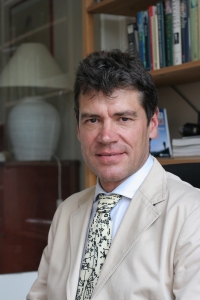Michael Perryman awarded prestigious Tycho Brahe Prize
6 June 2011
Professor Michael Perryman, the scientific leader of ESA's Hipparcos mission, and a founding father of its successor mission, Gaia, has been awarded the 2011 Tycho Brahe Prize from the European Astronomical Society. The prize recognises the extraordinary work accomplished by Perryman in shepherding the field of astrometry to its successful leap into space-based observations and demonstrating the importance of measuring stellar positions for a plethora of astronomical applications.
 |
|
Michael Perryman |
Astrometry, the branch of astronomy dealing with the precise measurement of stellar positions, has a long history that dates back to ancient Greece and even earlier civilisations. The invention of the telescope in the seventeenth century represented a fundamental turning point in the field, allowing the compilation of larger and much more precise catalogues of stars than the famous ones created by Hipparchus (in the second century BC) and Tycho Brahe (in the sixteenth century AD), who had charted the sky with the naked eye.
The accuracy in astrometric measurements increased almost continuously throughout modern history, along with technological improvements to astronomical instrumentation, until it reached a point in the second half of the twentieth century when further significant improvements seemed beyond immediate reach. Observational barriers imposed by the Earth's atmosphere limited the accuracy that could be achieved with ground-based measurements of stellar positions: the next leap for astrometry would require a dedicated space telescope.
The Hipparcos mission was conceived in the late 1960s by French astronomer Pierre Lacroute and, when accepted into the ESA science programme in 1980, Perryman was appointed project scientist. In this role, he ensured that the scientific goals of the mission remained the key drivers throughout the development of the satellite. Hipparcos was launched in 1989 and, with Perryman assuming the role of operations manager in addition, observed for 3.5 years before operations ceased in March 1993.
The scientific reach of the Hipparcos mission has gone well beyond astrometry and has had profound implications for the fields of stellar and galactic astronomy, as well as cosmology and fundamental physics.
This prestigious award recognises Perryman's "crucial role in the fostering of high precision, global stellar astrometry from space, in particular the development of the Hipparcos mission," and acknowledges his pivotal work leading this fully European enterprise "through many difficulties to its ultimate success."
The exciting progress of the Hipparcos mission, from concept to launch and beyond, including an account of its many astronomical applications, is reported in Perryman's book "The Making of History's Greatest Star Map", published in 2010. The mission is also presented, in the broader framework of astrometry, in a comprehensive textbook also written by him, "Astronomical Applications of Astrometry: Ten Years of Exploitation of the Hipparcos Satellite Data", published in 2009.
Notes to Editors
The Tycho Brahe Prize of the European Astronomical Society is awarded annually in recognition of the development or exploitation of European instruments, or major discoveries based largely on such instruments.
ESA's Hipparcos space astrometry mission was a pioneering European project which pinpointed the three-dimensional positions of more than one hundred thousand stars with high precision, and more than one million stars with lesser precision.
Launched in August 1989 Hipparcos successfully observed the celestial sphere for 3.5 years before operations ceased in March 1993. Calculations from observations by the main instrument generated the Hipparcos Catalogue of 118 218 stars charted with the highest precision. An auxiliary star mapper pinpointed many more stars with lesser but still unprecedented accuracy, in the Tycho Catalogue of 1 058 332 stars. The Tycho 2 Catalogue, completed in 2000, brings the total to 2 539 913 stars, and includes 99 per cent of all stars down to magnitude 11, almost 100 000 times fainter than the brightest star, Sirius. Central to the mission's success were four major pan-European scientific teams: the Input Catalogue Consortium led by Dr Catherine Turon (Paris), the NDAC and FAST Data Analysis Consortia led by Prof. L. Lindegren (Lund) and Prof. J. Kovalevsky (Grasse) respectively, and the Tycho Data Analysis Consortium led by Prof. E. Hoeg (Copenhagen).
Related publications
M. Perryman et al., "The Hipparcos Catalogue", A&A, 323, L49-52, 1997
M. Perryman, "The Making of History's Greatest Star Map", 2010 (book)
M. Perryman, "Astronomical Applications of Astrometry: Ten Years of Exploitation of the Hipparcos Satellite Data", 2009 (book)
Contacts
Michael Perryman
mac.perryman bristol.ac.uk
bristol.ac.uk
